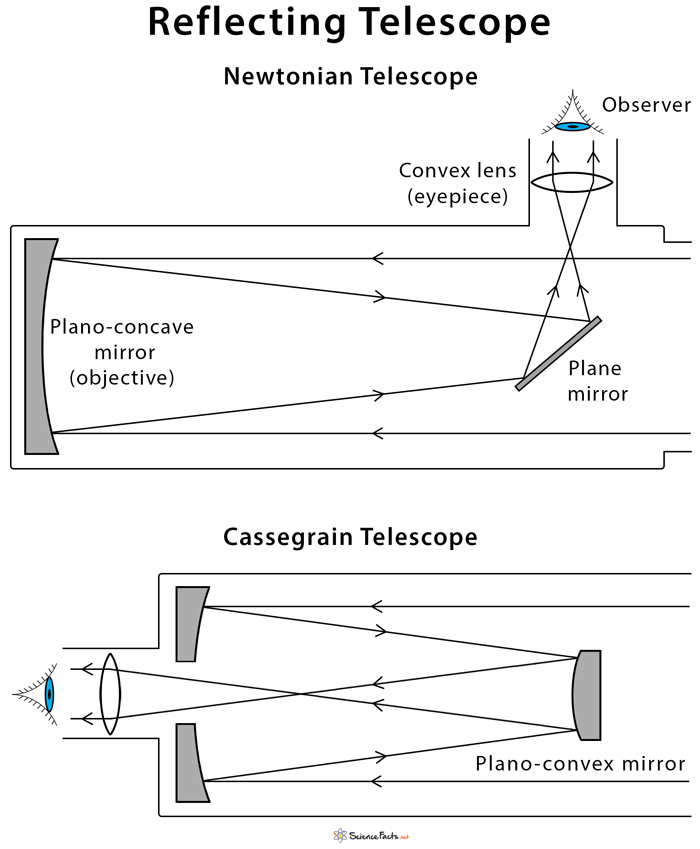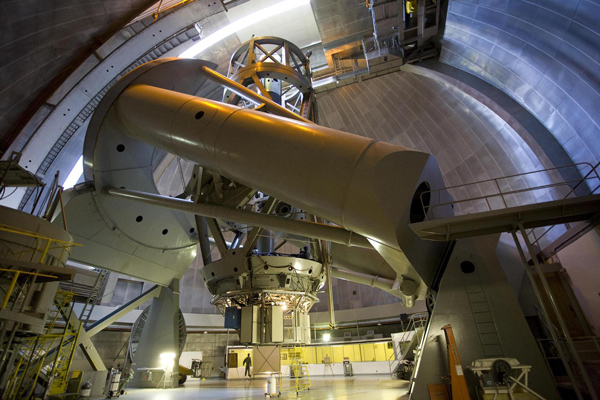Reflecting Telescope
Definition: What is Reflecting Telescope?
Reflecting telescope, also called a reflector, is a telescope that uses a combination of curved mirrors that reflect light and form an image of a distant object. In astronomy, it is used to examine the visible region of the electromagnetic spectrum as well as the shorter (ultraviolet) and longer (infrared) wavelength regions adjacent to it. Reflecting telescope is so-called because the primary mirror reflects the light to a focus instead of refracting it. The primary mirror usually has a concave spherical or parabolic shape and inverts the image at the focal plane. A secondary curved mirror, in combination with an eyepiece, is used to observe the image.
The history of the reflecting telescope goes back to 1668 when the famous British physicist and mathematician Sir Isaac Newton invented it as a replacement for refracting telescope. It was later named as the Newtonian telescope, which was constructed from a concave primary mirror and a flat diagonal secondary mirror.
List of Some Popular Reflecting telescope
Some notable reflecting telescopes across the world and in space are
- Hale Telescope at Palomar Observatory
- Keck 1 and Keck 2 at W.M. Keck Observatory
- Large Binocular Telescope at Mount Graham International Observatory
- Gran Telescopio Canarias at Roque de Los Muchachos Observatory
- Giant Magellan Telescope at Las Campanas Observatory
- Hubble Space Telescope
Image Courtesy: Jpl.nasa.gov
Parts and Components of Reflecting Telescope
- Tube assembly: The large part of a telescope in the shape of a long cylindrical tube that holds the primary mirror, secondary mirror, eyepiece, and holder.
- Mount assembly: The assembly that supports and moves the telescope tube.
- Eyepiece assembly: It is a knob used for focusing the image and a sleeve for inserting eyepieces of different sizes.
- Counterweight: A block of heavyweight that can be slid up and down on a metallic bar to balance out the telescope and make it very easy to maneuver.
- Motor: It is used to turn the telescope to point it at an object and automatically follow the object across the sky.
Design of Reflecting Telescope
Reflecting telescopes uses two mirrors, called the primary and secondary mirror, as well as a glass lens (eyepiece) in their lens system. Light rays gather through the aperture and travel to the back of the telescope where the primary mirror is located. The primary mirror is shaped parabolically so that all incoming parallel rays will reflect off the mirror at their specific angles and hit the surface of the secondary mirror. Another reflection will occur, and all the rays will converge to a single point called the focal point. Light rays continue to travel and refract at the eyepiece lens and form an image that is magnified according to the user’s observation. However, this image is inverted to the original image.
Magnification of a reflecting telescope mainly depends on the distance of the eyepiece lens from the focal point, i.e., the focal length of the eyepiece. Typically, a long objective focal length combined with a short focal length of the eyepiece lens will yield higher magnification. However, magnification is not the critical optical property for viewing astronomical bodies. The aperture size is crucial because it accounts for the amount of light the telescope receives. In other words, the more the light, the brighter the image. The size of the aperture also accounts for the resolution of the telescope. Larger aperture size will yield a high quality of image, crisper with increased clarity of the image.
Types of Reflecting telescope
The three main kinds of reflecting telescope are
- Newtonian Telescope: In this kind of reflecting telescope, a plano-concave primary mirror deflects the incoming light to a diagonal secondary mirror. The light is then reflected towards the side of the telescope, where the eyepiece is located. This design is usually used in smaller telescopes.
- Cassegrain Telescopes: In this kind of reflecting telescope, the primary mirror is still plano-concave, but the secondary mirror is plano-convex. It reflects light through a hole in the primary mirror’s center. The reflected light is then collected by the eyepiece located behind this hole. More astronomical reflecting telescopes use this design, often called Cassegrain focus.
- Schmidt-Cassegrain telescopes: It is a variation of the Cassegrain telescope and used in many high-end telescopes. The reflecting telescope is designed in such a way that it has a thin correcting lens (Schmidt corrector plate) at the front of the telescope tube in order to improve the image.
Advantages of Reflecting Telescope
- Absence of chromatic aberration in mirrors because wavelength does not affect reflection
- The primary mirror is more comfortable to mount since the back of the mirror can be used to attach to the mount
- Because of reflection rather than refraction, only one side of the mirror must be perfect
- Cost-effective and cheaper to make than refracting telescope of the same size
Disadvantages of Reflecting Telescope
- Optical misalignment can occur quite easily
- Mirrors and other optical components have to be frequently cleaned as they are exposed to air
- Air currents inside the telescope will cause images to be fuzzy if the optics are not kept at the same temperature as that of the ambient air
- Secondary mirror redirects the light into a more convenient viewing spot but can lead to diffraction effects (“Christmas star effect”)
Difference between Refracting and Reflecting Telescope
Reflecting Telescope vs. Refracting Telescope | |
| Reflecting Telescope | Refracting Telescope |
| Uses mirrors | Uses lenses |
| Has a lower cost | Has a higher cost |
| Easy to produce as only the reflecting side of the mirror needs to be perfect | Difficult to produce as lenses must be prepared with the utmost care using pure materials |
| Requires maintenance, especially collimation | Low maintenance required because they do not need to be collimated |
| Can be made more prominent using an array of mirrors | Maximum size is limited to one meter |
| Distortion and aberration are minimum | A giant refracting telescope can cause distortions and suffer chromatic and spherical aberrations |
| Popular in astronomy since they can see much farther and much clearer | Popular in photography and used in binoculars and cameras due to their simple design |
FAQs
Ans. Isaac Newton has been generally credited with building the first reflecting telescope in 1668.
Ans. The largest reflecting telescope is the Gran Telescopio Canarias in La Palma, Spain.
-
References
Article was last reviewed on Thursday, February 2, 2023









